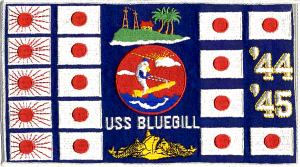USS Bluegill (SS242) was authorized on 9 September 1940; the keel laid 17 December 1942 at the Electric Boat Company, New London, Connecticut; launched 8 August 1942; and commissioned 11 November 1943.
USS Bluegill conducted the following patrols during World War II, sinking 14 ships, including a cruiser and a transport with approximately 6,000 Japanese soldiers aboard, damaging 3 ships and capturing an island.
1st War Patrol: 1 April to 1 June 1944, in the vicinity of Morotai, Halmabera, Pulo Anna and Sonsoral Islands.
2nd War Patrol: 6 July to August 1944, in the vicinity of Davao Gulf, Mindanao, Philippine Islands.
3rd War Patrol: 18 September to 25 November 1944, in the vicinity of Makassar Strait, Sulu Sea, and off Manila, Philippine Islands.
4th War Patrol: 19 December 1944 to 10 February 1945, in the South China Sea.
5th War Patrol: 12 March to 18 April 1945, conducted in Java Sea and in the South China Sea off French Indo-China.
6th War Patrol: 11 May to 21 June 1945, conducted in areas south of Swatow, China and southwest of Formosa.
Bluegills’ first encounter with the enemy was as one of several submarines that participated in the campaign against Hollandia. The submarines formed a blockade line between Morotai and Palau. The object of the blockade was twofold; primarily to prevent an enemy task force from intercepting our force, and secondly, to prevent high speed transport convoys from stealing through at night. The Japanese garrison was in dire need of supplies. It was on this station that Bluegill successfully executed a submerged attack on the Japanese cruiser Yubari. The cruiser was sunk with two torpedo hits as she pulled away from the fuel dock at Sonsoral Island. Following the encounter Bluegill was subjected to a depth charge attack by five destroyers. Several days later a convoy was encountered and a 8,812 ton cargo vessel sunk. Near the end of the patrol, operating off Halmabera, a gasoline tanker was sunk less than 30 miles from the airfield which was the destination of the fuel.
The Japanese Naval Base at Davao Gulf as the locality of Bluegill’s second patrol. The first attack was unsuccessful. Six torpedoes were fired at a large cruiser but she successfully maneuvered to avoid. Attack number two presents a brighter story: The first salvo fired accounted for a loaded transport and a Chidori class escort vessel. A short time later, another attempt of the enemy to supply the beleaguered base was frustrated. Scratch one more loaded transport.
Bluegills’ third war patrol was outstanding. In a period of fourteen hours, 32,000 tons of troop laden transports, four transport vessels and one escort, were sent to the bottom. The counter-attacks by the Japanese escort vessels following the several torpedo attacks were terrific and only through great skill in evasion was the Captain able to save his ship. Diving under one of the sinking ships and remaining under her as she broke up and sank was one of the clever, but dangerous, maneuvers which caused the enemy to lose contact. Two surface engagements with the enemy sent another 2,000 tons to the bottom. The second of these attacks will not be forgotten for the enemy succeeded in raking the bridge and wounding the gun crew before small caliber weapons could be brought into action.
Japan’s supply lines to her rich, conquered territories in the South were nearly severed, but occasionally she would attempt to sneak a convoy through. Bluegill, on her fifth patrol had the honor of sinking the last ship to be sunk by a submarine in the South China Sea. Operating as a member of a wolf pack, Bluegill engaged the convoy off the coast of Indo-China. The other members of the pack were severely depth charged and forced to retire. Bluegill pressed the attack home, sinking the prize of the convoy, a tanker. Another ship failing to reach its half starved owners.
Air-Sea rescue service for the 5th Air Force was Bluegill’s duty on her last patrol. Lying several miles off the rugged coast of Formosa, watching the B24’s and B25’s deliver their bomb loads, waiting to pick up downed pilots was essential service but not very exciting. Climaxing her cruise, the crew of Bluegill swarmed ashore and with small arms and sabers, captured Pratus Atoll, a Japanese radio and weather station. In a very appropriate ceremony the U.S. flag was raised and the island renamed "Bluegill Island."
For her first and third patrols, Bluegill was awarded the Navy Unit Commendation, and her skipper, Commander Eric L. Barr, Jr., received the Navy Cross. Following World War II, The submarine Bluegill continued to serve in the Pacific Fleet until placed in reserve on 1 March 1946.
